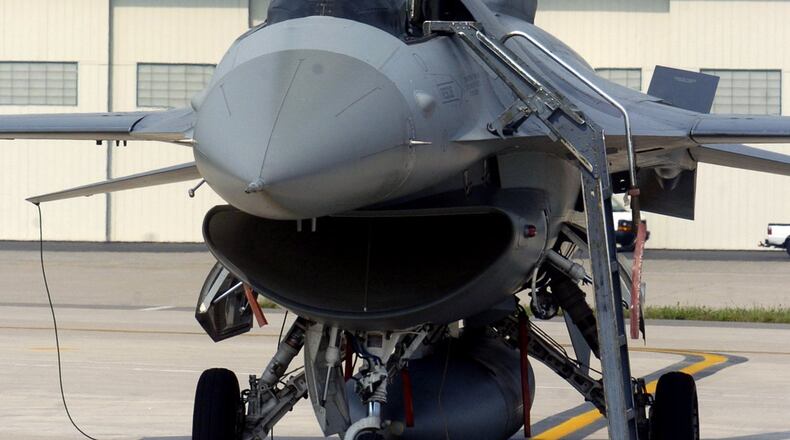“I think right now, the fact that they reached out to us directly by name and said, ‘Hey, we’re very interested in the skill set at the 178th ISR group, would you be interested in entertaining a space mission,’ I think that in and of itself is a very optimistic story,” Camp added, using the acronym for “intelligence, surveillance and reconnaissance.”
It was too soon to say when and how the wing would fit into an emerging Space Force, the one-star general cautioned. “I have to tell you, there are a lot of unanswered questions,” Camp said.
At a change of command ceremony Sunday, Camp announced the Springfield Air National Guard unit was aiming for a role in the new Space Force.
“I’m happy to say that it looks like in the very near future, our ISR group may switch to a space intel mission,” Camp said.
With nearly 1,000 members, it is the 178th’s mission to conduct support for intelligence, surveillance and reconnaissance operations at the federal and state level. As part of that role, the wing consists of four intelligence squadrons supporting national and combatant command work at the National Air and Space Intelligence Center (NASIC), based at Wright-Patterson Air Force Base.
Col. Kimberly A. Fitzgerald — who made history Sunday by becoming the 178th Wing’s first woman commander — also said the unit was “throwing its hat in the ring to be a part of the Space Force mission.”
An Air National Guard unit such as the Ohio Air National Guard’s 178th Wing could do more than support a new U.S. Space Force — its members could be a source of skills that are rare even in the regular armed forces, one defense analyst said.
“A lot of these National Guard units contain skills that are hard to come by in the regular military,” said Loren Thompson, chief operating officer of the Arlington, Va.-based non-profit Lexington Institute and chief executive of Source Associates, a defense-focused consulting business. “Depending on what they do in their civilian lives, some of these National Guard people may actually have superior space-related skills.”
Software and application engineers, for example, may offer “extreme expertise that is hard to come by.”
Added Thompson: “If the National Guard and other Reserve units want to get in, they really need to move fast.”
In June 2018, President Donald Trump ordered the Pentagon to begin planning for a “Space Force,” a sixth independent military service branch to undertake missions and operations in the increasingly crucial domain of space.
And announced this summer: A new “U.S. Space Command” will be the military’s unified combatant command in charge of the country’s defense operations in space. It will become the Defense Department’s 11th unified combatant command, alongside the U.S. Strategic Command, the U.S. Special Operations Command and other commands that serve specific functions or geographic regions.
Thompson said a guard unit could provide several different kinds of support to a new Space Force.
Citizen-soldiers and airmen could analyze information provided by satellites, he said. They could write software and software applications. And they could be operationally engaged, being deployed where necessary.
“The Space Force is a growth story,” Thompson said. “Today, it consists mainly of satellites and control stations on the ground. But the plan is to greatly improve the resilience and the functionality of U.S. spacecraft by spending billions of dollars over the next 10 years.”
Russia and China are increasingly a threat in the space arena, Thompson said. The U.S. must rise to meet that challenge,
“We’re not talking here about flying in space to shoot lasers,” he added. “What we’re talking about here is operating and protecting satellites that have a role in America’s global warfighting posture.”

